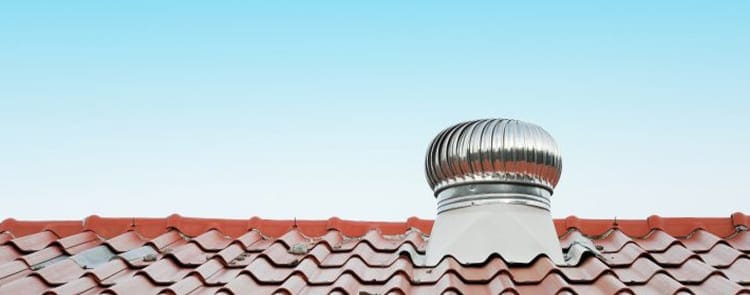Blogs
How To Cut Costs With Proper Ventilation and Attic Vent Fans
5/6/2016

Forced air systems, powered ventilation, and climate control in your home are all beautiful technologies that make life easier. They also require a lot of power and regular care to ensure continued productivity.
But just as important is how you deal with heat transfer through your attic, in both the winter and the summer months. Good insulation and sealing for your ventilation system and attic floor are essential, but passive systems for ventilation keep your attic refreshed (not cold) in the summer, and cold in the winter.
Attic Ventilation and Insulation
Keeping your attic a different temperature from your home may seem counter-intuitive, but it’s key to reducing cooling costs in the summer and preventing damaging ice dams in the winter. The attic is designed as a buffer against the direct radiation heating of the sun. It absorbs heat and limits that transfer using air as an insulator.
While your roof collects a great deal of heat during the summer, it doesn’t transfer as much into your home because that heat radiates into the attic. Vents on the roof allow that heat to escape upward, pulling air in from the soffit vents at the edges of your roof. This keeps your attic (when properly vented) cool enough to act as a heat barrier between the warming power of the sun and the cooling power of your forced-air HVAC system.
If you’re seeing excessively hot attics (or getting a draft from inside your home into the attic), check the attic vent fans to make sure that the soffit intakes are not blocked by insulation and that the exhaust vents have not been nested in or blocked by debris. The goal is not to make your attic as comfortable as your home, there’s no reason to waste energy that way, but to create a barrier from the sun. If you want to keep your attic cooler, grow shade trees around the home to shield your roof from extra sunlight in the morning and evening.
Whole House Fans VS Powered Attic Fans
When we talk about fans, two types show up: whole-house fans and powered attic fans. Powered attic vent fans have a lot of controversy surrounding their effectiveness. Since proper venting is effective at reducing energy losses, there’s little reason to go into the argument for or against powered fans here. A powered fan runs the risk of using extra energy (or creating a negative pressure zone) if your vents are blocked, to begin with. If you’re going to use a powered fan, always make sure that the soffit and gable vents are not blocked.
Whole-house fans, on the other hand, are not about ventilating your attic. These fans are designed to cool your home during the night by circulating air throughout the home while the sun is down. While they’re effective at night, bear in mind that:
- They require the windows to remain open, which can be a security issue
- They draw in outside air which needs to be cooler than internal air
- Outside air is typically higher in humidity than indoor air
A whole-house fan is definitely worthwhile in the spring or fall when temperatures are milder. Usually, a house designed with a fan doesn’t have a refrigeration-based forced air system installed because of issues with humidity control. If you’re going to use an air conditioner during the day, it’s best to just use the HVAC system rather than trying to switch between the two systems every day.
Thank you for making Service Legends the #1 provider of residential heating and air conditioning in the Des Moines area. A live and friendly customer care representative is ready to take your call 24/7 at 515-COMFORT (515.266.3678).
Learn more on how to cust summer cooling costs.
515-657-6634Request Appointment Online
Return- October 2024
- June 2024
- January 2024
- October 2023
- September 2023
- August 2023
- January 2023
- December 2022
- November 2022
- October 2022
- September 2022
- August 2022
- July 2022
- June 2022
- May 2022
- April 2022
- March 2022
- February 2022
- January 2022
- May 2021
- November 2020
- October 2020
- September 2020
- July 2020
- June 2020
- May 2020
- March 2020
- February 2020
- December 2019
- November 2019
- September 2019
- May 2019
- April 2019
- January 2019
- December 2018
- November 2018
- October 2018
- July 2018
- October 2016
- September 2016
- August 2016
- July 2016
- June 2016
- May 2016
- April 2016
- March 2016
- February 2016
- January 2016
- December 2015
- November 2015
- October 2015
- September 2015
- August 2015
- July 2015
- June 2015
- May 2015
- April 2015
- March 2015
- February 2015
- January 2015
- December 2014
- November 2014
- October 2014
- September 2014
- August 2014
- July 2014
- May 2014
- March 2014
- February 2014
- January 2014
- December 2013
- November 2013
- October 2013
- September 2013